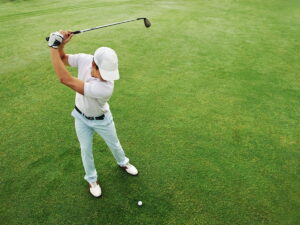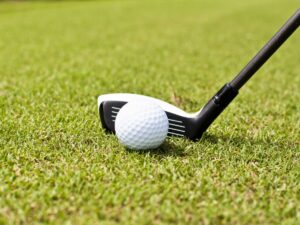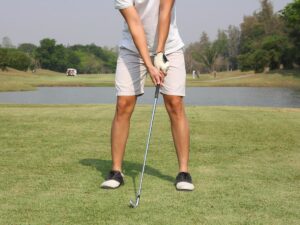
How to Hit Down on Irons & Master Your Ball Striking
*This post may contain affiliate links. We are reader supported and earn affiliate commissions when you buy via links found on our site*

- Last Updated on
Contents
Learning how to hit down on irons is one of the most important skills in golf.
When you hit down on the golf ball – specifically with irons and wedges – you’ll hit it longer and find the sweet spot more than you thought possible. Of course, this is easier said than done for most everyday golfers.
Hitting down for optimal compression is about the right mechanics, takeaway, and setup position. Today we’ll address some common swing faults that most golfers make to help you hit better iron shots for more consistency on the golf course.
How to Hit Down on Irons
Hitting irons and wedges is much different than hitting a driver or fairway wood off a tee.
With irons, you want to hit down on the golf ball (also known as “covering” the ball) at a descending angle of attack. This allows the club to compress slightly with your hands ahead of the shaft – known as forward shaft lean.
When done correctly, this leads to a crisp divot where you hit the ball, then the turf with a descending blow. Think about it like this, you need to hit down on the shot for it to go up – the loft will take care of the rest for you.
But most golfers try to scoop the ball up and don’t hit down on their irons. This leads to a lot of thin and fat shots – even if you play forgiving, cavity back irons.
Think about it in terms of “low point” – this is the club’s lowest position in the arc of your swing. For irons, the low point needs to be in front of the golf ball as this is where you want to take your divot – not behind the ball.
To take your game to the next level, you need to work on compression and getting into the right position at impact. Follow these steps to hit your irons better than ever.
Check Your Ball Position
First things first, to hit down on your irons correctly you need the right ball position in your stance.
One of the biggest mistakes most golfers make is playing the ball too far forward in their stance. When the ball is too far forward, it’s nearly impossible to hit down on the ball as the club is already past the low point.
Think about it like this…
The shorter the iron (or wedge), the more it should be in the center of your stance. While longer clubs need to be slightly further up in your stance to account for the longer shaft length. This will also allow you to make a proper weight shift and bottom out at the correct position.
If you’re hitting a lot of thin shots now, get the ball more in the middle of your stance. If you’re hitting a lot of fat shots, try to play the ball more forward in your stance. Sometimes simply changing the ball position can lead to huge improvements in your contact.
Get Your Hands Ahead
If you watch the best players in the world hit irons and wedges you’ll notice their hands are ahead of the ball at impact. This leads to compression and actually delofting the club slightly.
To compress your irons you need to make sure your hands are ahead, not behind the golf ball at impact.
To get into this powerful position start by making sure the handle of the club is slightly ahead of the ball at address. This position will help get the low point ahead of the ball, not behind it. This subtle move can also help you from making a “scooping” motion which keeps your hands behind the ball at impact.
Maintain Good Posture
Next up is your posture – a top reason that most golfers struggle with solid irons is they don’t have the same posture throughout their swing. Remember, you don’t need to lift the ball and help it up in the air – that’s what the club loft does.
Unfortunately, too many golfers straighten up their posture and try to assist the ball in the air. This is known as early extension which leads to a lot of big misses with irons.
Instead, the goal is to get into a strong, athletic posture at address and maintain it throughout the swing.
As a PGA instructor said, “After establishing your posture and the distance between your sternum and the ball, the goal is to return to the same distance between you and the ball at impact. You should feel like you’re sitting — or staying back on the ball — instead of standing up.”
Spotting early extension in your swing is pretty easy when you record your swing from a down the line angle. This makes it easy to see if you’re changing your spine and raising up on the downswing.
If this happens in your swing try to feel like your chest stays over the golf ball and test out the drills below.
Drive Your Right Side
To cover your irons better you also need to drive your right side toward the target.
As Butch Harmon said in Golf Digest, “This prevents you from slowing down before impact and trying to flip or scoop the ball off the ground. Good iron players really fire that right side, extending the right arm and pushing through with the body. Think of a shortstop throwing hard to first base for a double play; nothing stays back.”
The key to driving your right side properly is to begin the downswing with a subtle shift to your left side. If you watch PGA Tour players in slow motion you’ll notice they actually shift the weight to their lead leg before the downswing begins. This allows them to use ground force to create power in their swing and get the weight off their back leg.
But a lot of golfers leave their weight back leg which leads to changing their posture and/or raising up on the downswing. Always remember to start your swing with your weight shift as you’re turning your hips.
Don’t simply start the downswing by rotating your lower body with the majority of your weight on your back leg.
Hit Down on Iron Drills
Now that you have a better understanding of the fundamentals of covering the ball, here are some of our favorite drills and training aids.
Front Leg Drill
If you’re hitting irons thin or fat consistently, one of the biggest causes is a lack of weight transfer. To feel a proper weight transfer get a short iron or wedge and set up like normal. Then, take your back foot and put all your weight on your toes so your heel is off the ground.
Doing this will automatically move your weight to your lead leg. From this position, make 50-70% swings to make ball first contact. Since your weight is forward it should be easy to make solid contact with forward shaft lean.
Do this 5–10 times and feel the rotation around your body. Then hit 5-10 normal shots with your feet on the ground to feel the weight stay more on your left side. This is an easy drill that can pay off big time for your ball striking.
Towel Drill
Grab a small washcloth or hand towel and set it up about six inches behind the golf ball. Then set up with a wedge and take some swings. The club should not hit the towel on the backswing or the downswing.
On the backswing, the towel should help you hinge your wrists properly and avoid a low, inside takeaway. On the downswing the towel can provide visual feedback to transfer your weight so you can bottom out correctly.
Try Out a Wrist Trainer
While these drills will help develop a more consistent swing, you might need to improve your wrist action as well. Because another common cause for thin and fat shots is not hinging the wrists properly.
Some golfers take the club back too far inside and hinge their wrists too late in the swing. While others hinge too quickly on the backswing for a steep plane.
To help get your wrists in the right position try out one of these two training aids.
- SKLZ Wrist Hinge Trainer: This low-price training aid is a staple for most golf instructors as it promotes setting the wrist early for proper club rotation. It attaches to your wrist and the club to feel the correct wrist position at the top of your backswing. Plus, it’s easy to use and works for right and left-handed golfers.
- Hanger Training Aid: This newer training aid improves club face control and gets your wrists in the correct position at impact. It’s also very easy to use but make sure you buy the right model as there is a separate device for right and left-handed golfers.
Top Questions About Irons
Want to learn more about hitting pure iron shots? If so, continue reading through our top questions and answers now.
How do I make sure I hit down on a golf ball?
One of the most important parts of hitting down on a golf ball is a good weight transfer.
If your weight is on your back leg at impact, you will hit up on the golf ball. This leads to hitting the ball with the bottom grooves of the club which produces a thin miss.
With the right ball position and proper weight transfer, you can hit down on your irons and wedges much easier. If you struggle with a proper weight shift invest in a training aid like the Pressure Plate from Why Golf. This easy to use device helps you train your swing to hit down and through the shot more often.
What does it mean to hit down on irons?
Hitting down on irons refers to making contact with the ball, then the turf… not the other way around. If you watch guys on the PGA Tour you’ll notice their divot is ahead of the ball, not behind it. This is because they have such good mechanics they’re able to create forward shaft lean and compression at impact.
Unfortunately, most everyday golfers don’t have as good of mechanics which leads to a divot that is behind the ball (which produces a “fat” shot). Or, no divot at all which can lead to a lot of thin golf shots.
How do you take a divot every time?
Taking a divot every time is all about ball position, timing, and bottoming out at the right part of your swing. Sometimes it’s as simple as moving your ball position so you change your plane and take divots more often.
Why don’t I ever take a divot?
You should not always take a big divot, depending on the club you’re hitting.
For example, if you’re hitting a longer club – like a driving iron or hybrid – you don’t want much of a divot at all. But if you never take a divot with irons or wedges, this could be a problem.
The main issue is that you’re not “bottoming out” at the right part of the swing. It’s important to remember that you should make contact with the back of the ball, then the grass. Not the other way around.
Scroll up to review some of our best tips and drills to improve your ball striking and hopefully take more divots.
Is it bad if I don’t take a divot?
It depends on the club you’re hitting and the turf you’re playing from.
For example, if you’re hitting a mid to long iron it’s not that uncommon to barely take a divot. Or, a very thin divot that doesn’t need much sand to fill.
The turf itself plays a role too – wet conditions make it easier to take bigger divots than firm, hard grass that you might get in summer conditions.
If you’re playing in perfect conditions and hitting a wedge without a divot it might be a problem. But it’s situational and player dependent and some golfers have a swing plane that doesn’t yield big divots.
Wrapping Up
To hit your irons pure and crisp, you need the low point ahead of the golf ball. This power move comes from different parts of your setup and swing to hit the ball, then the turf with your irons.
Remember, your divot should be ahead of the ball, not behind it.
Finally, if you don’t make huge divots even when you hit it well, don’t beat yourself up. Some golfers have a swing plane that doesn’t yield as big of a divot even when they make pure contact. Plus, the golf course conditions also play a big role as well.
Do you have a more shallow or deep divot pattern? Is this something you’re trying to fix in your game?
Let us know in the comments below.

Michael Leonard
Michael Leonard is a full-time writer, author, creator of Wicked Smart Golf and +1 handicap amateur golfer. He left his corporate career in 2017 to pursue entrepreneurship and professional golf; since then, he’s competed in 160+ tournament days and went to Q-school in 2019.





